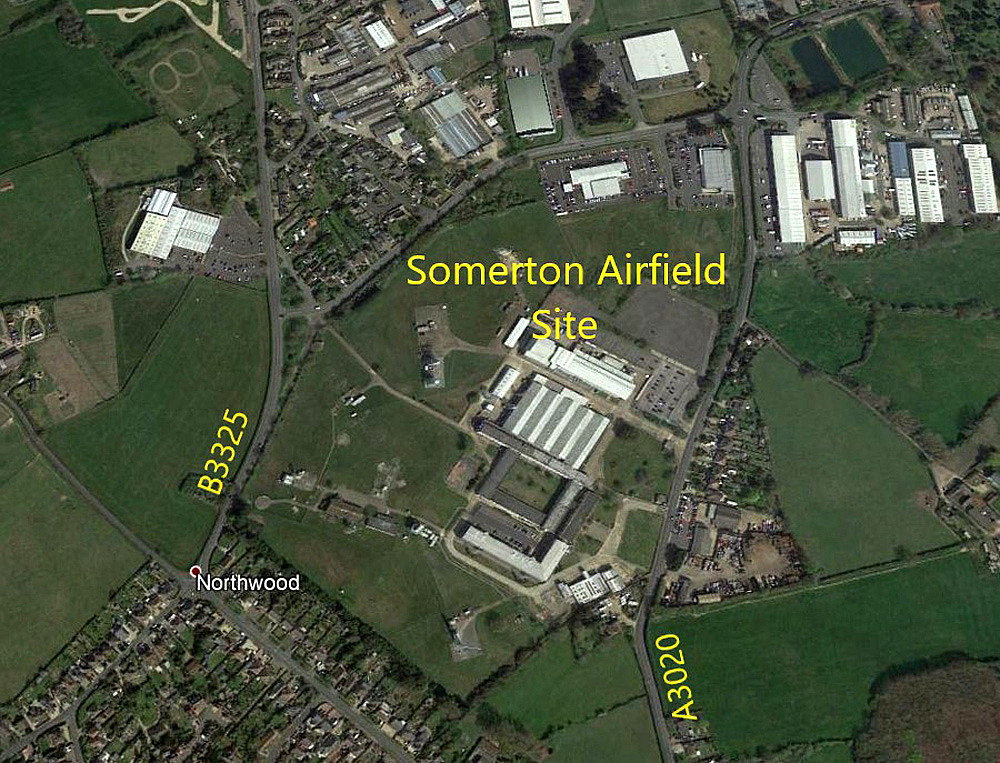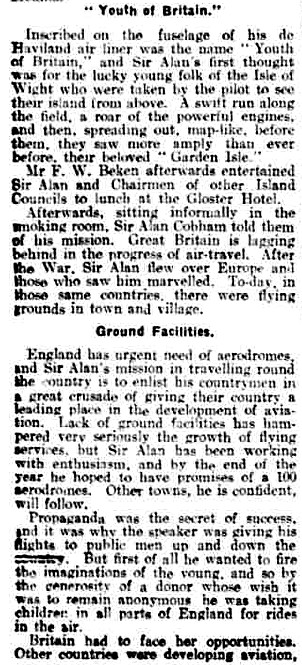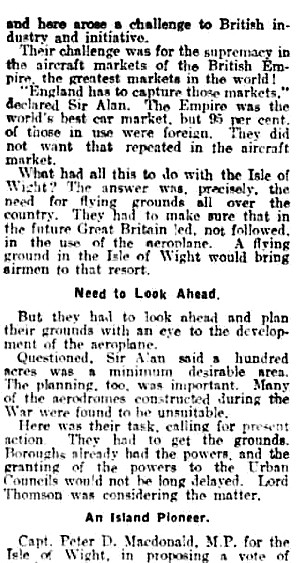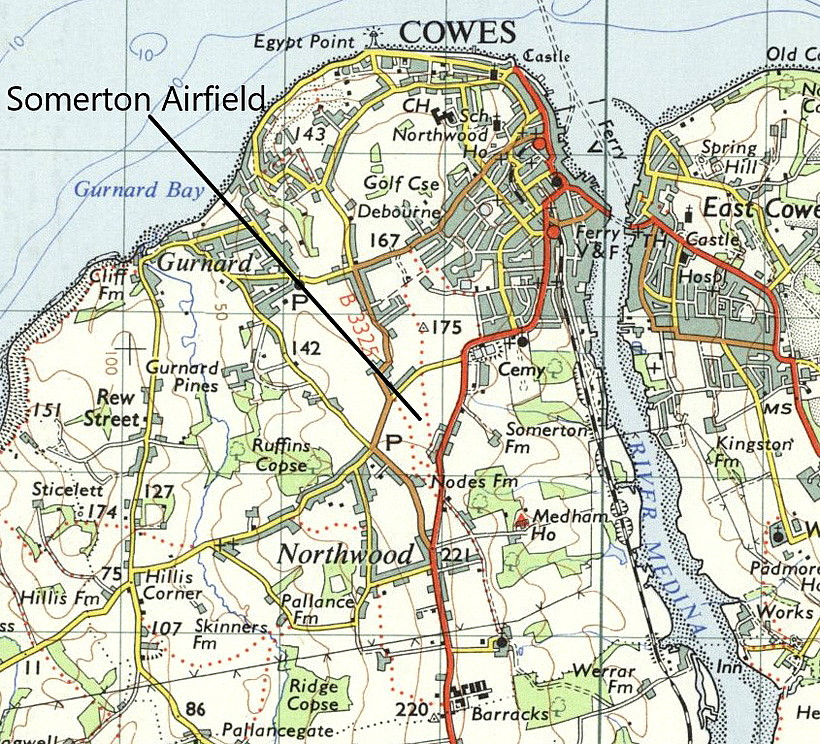Cowes West
COWES (WEST): Military and later civil regional airport (aka SOMERTON, SOMERTON FARM and WIGHT)
(Much later helipad for B.A. Systems)
Note: This picture was obtained from Google Earth ©
The large 'H' denoting the helipad, (image date 2005), can be clearly seen to the SW of the main factory complex.
Military users: RAF (Royal Air Force)
DLG (Day Landing Ground) for SACCDB (School of Aerial C-Operation) 1918
RAF School 1918 to 1919
Operated by: Civil from 1929: S E Saunders Ltd. 1933: Saunders-Roe
British airline users: Pre 1940: British Air Transport, Brooklands Aviation, Railway Air Services, Spartan Air Lines
Charter operators: Pre 1940: Air Enterprises, Barclays International Airways
Pleasure flights: Pre 1940s: Air Trips
Manufacturing: J S White (Factory in Cowes) 1930s: Spartan/Saro
Location: 1nm SSW of Cowes. A large works, W of the A3020, NNE of Northwood, just E of the B3325, just SW of Cowes
Period of operation: Military 1918 to 1919. Civil 1930 to 1951
Site area: WW1: 60 acres 786 x 439
Runways: 1933: N/S 457 grass NE/SW 686 grass
E/W 366 grass SE/NW 366 grass
NOTES: During 1918 and 1919 BE.2c’s operated for the School of Aerial Co-operation. There appears to been little activity (if any?) until 1929 when S E Saunders were sub-contracted by Blackburn to build the Bluebird type.
A MICHAEL T HOLDER GALLERY
On the 20th August 1929 Sir Alan Cobham landed here during his Municipal Aerodrome Campaign tour of most of the U.K. The tour, starting in May and ending in October was originally planned to visit 107 venues, but due to a couple of crashes and other setbacks, he eventually managed to visit 97. Even so a quite magnificent achievement.
The aircraft he mostly used was the ten-seater de Havilland DH61 'Giant Moth' G-AAEV, named 'Youth of Britain'. Typically he would arrive around 11.00 to be met by local dignitaries who he took for trips around the local area. This would be followed by a slap-up luncheon when he would extol the benefits of having a local aerodrome/airport. He would then take groups of pre-selected children for flights, the costs being met by an anonymous donor, who we now know was Lord Wakefield of Castrol Oil fame. Lastly he would take fare paying passengers for flights, usually until dusk. He would keep up this punishing schedule for day after day, with very few breaks for resting along the way.
This article was published in the Portsmouth Evening News on the 20th August 1929.
Note: The 9th and 12th items are from my Google Earth © derived database.
MORE INFORMATION
To quote from The Triple Alliance by Neville Doyle; “In 1933…..There were two wooden hangars, one 25 ft x 34 ft and the other 46 ft x 42 ft, and one steel hangar 60 ft x 67 ft. All three were located beside the Newport road towards the southern end. It was a private airfield under the control of Saunders-Roe and ‘The Air Pilot’ warned of stock grazing on the landing area.”
From April to October 1933 Spartan Air Lines operated a regular service here from HESTON. In those days it was common for many if not most airlines to operate seasonal regional services when the weather was liable to be favourable. Is this also probably the venue where Sir Alan Cobham’s 1935 No.1 Tour visited on the 11th August when displaying in/near COWES.
Note: This picture from a postcard was kindly sent by Mike Charlton who has an amazing collection. See, www.aviationpostcard.co.uk
The reason I think it might well be a picture taken in the early 1930s is because an aircraft closely resembling a Spartan Cruiser can clearly be seen. But, there is no sign of anything resembling a 'terminal' building such as seen in the picture above. All of which, I suppose, begs the question; Could this be a rare picture of the aeroplane described below?
I was also interested to learn from Neville Doyle in his book The Triple Alliance that, “… the Australian designer, Capt. Edgar Percival had designed a wood and ply low-wing monoplane powered by three Gipsy engines to carry 1,000lbs of mail 1,000 miles. Agreement was reached for this to be built by Saunders-Roe as a joint venture. Although it was actually registered as G-ABLI in April 1931 to Spartan Aircraft Ltd and in its original form was known as the Saro-Percival A.24 Mailplane making its first flight at Somerton, Cowes-West on June 1st 1931. The Mailplane’s wing span was 56ft, the wing area 470 sq ft and the cruising speed 105mph. Weights were 4,425lbs tare, 5,645lbs all-up.”
So, obviously it was hopelessly inadequate for its intended task
“Percival soon sold his interest in the design to Saunders-Roe and the project was handed over to their associated company, Spartan Aircraft Ltd for further development as the Saro/SpartanMailplane. With two extra seats behind the pilot and two small windows, it was christened “Blackpool” at Stanley Park aerodrome on June 15th 1932 before taking off on a flight to Karachi which was accomplished in ten minutes under six days. The pilot was Neville Stack and he was accompanied by engineer Fred Taylor and William Courtenay, the well-known journalist, air-correspondent and public relations man.”
“Despite its name the aircraft was never used to carry mail, and after some trials in Egypt, it was scrapped in Feburary 1933, but the design did lead directly to the Spartan Cruiser.” It also made me wonder if the concept might have influenced the de Havilland DHA-3 Drover? The general spec, given the Drover first flew in 1948, shares a few similarities. Such as a wing-span of 57ft, a cruise speed of 108 knots and a tare weight of 4,000lbs and range of 890 miles.
All-in-all not much better than a design first flying fifteen years before.
A TIMETABLE
In his book The Triple Alliance Neville Doyle provides an example from the Spartan Air Lines timetable published in 1933 which I firmly believe is well worth creating a facsimily of for this Guide. The most remarkably similarity being that it so closely resembles the sort of ‘patter’, when in flight of course, that I had followed flying passengers to the Isle of Wight in a Cessna 172 years ago, and mindful of the fact that some had never flown before – and most not in a light aircraft.
No major airline today could ever hope to replicate such an experience. And, no airline today would operate ‘airliners’ such as the Spartan Cruiser so damned difficult to board!
POINTS OF INTEREST ON THE LONDON – ISLE OF WIGHT AIR LINE SERVICE
AIRWAY TERMINUS, VICTORIA STATION, S.W.1, is the Headquarters of Imperial Airways, Ltd.
Convenient for all parts of London. Waiting room, buffet, etc. Formalities are simple, and take but a few minutes. Passengers’ luggage is taken over and registered receipt given in return. On presentation of the receipt the luggage is placed on the ‘bus or passenger’s own car at the Aerodrome of destination.
The Spartan Air Line ‘bus leaves the Airway Terminus at scheduled times of departure, and proceeds to Heston Airport, where passengers and their luggage are conveyed to the air liner. Heston airport has a licensed restaurant and all conveniences for passengers.
ON LEAVING HESTON AIRPORT the pilot may vary his route slightly, according to the weather conditions. The most usual route in fine weather is the direct one of 70 miles to Ryde. The first land-marks after leaving the airport are the two large sheets of water which are Staines and Laleham Resevoirs. The River Thames is crossed, leaving Chertsey on the right, and the next large place which a passenger can pick out is the town of Woking on the left. Here the main Southern Railway Line to the West of England is traversed, and the Bisley rifle ranges can be seen on the right. After but a few minutes’ flight the line of the Hog’s Back, running from Guildford to Farnham, can be traced a few miles away to the left, while on the opposite side can be picked up the military cantonments and parade grounds of Aldershot and its surrounding barracks.
The pilot passes almost directly above the town of Farnham, and shortlyafterwards the well-known beauty spot of Frensham Ponds is seen on the left, while further away the ground rises towards Hindhead Beacon and the Devil’s Punch Bowl, which can be picked out on a clear day. The grass country of Hampshire now takes the place of the pine-wooded country near London. The market town of Petersfield is passed over, and almost immediately the hills between there and the coast are crossed, and ahead on the left can be seen Hayling Island and Chichester Harbour, with Langstone Harbour and Portsmouth on the right. Here, owing to prohibited area regulations, a small detour has to be carried out, and then the course is set direct to Ryde, Isle of Wight.
At RYDE the Aerodrome is situated just outside the town on the main Ryde/Sandown/ Shanklin road. Frequent ‘bus services for Ryde, Sandown and Ventnor pass the entrance of the Aerodrome, while connections can be made to all other parts of the Island. Taxis can be procured at short notice or can be ordered in advance to await the arrival of the air liner.
On leaving Ryde the air liner travels direct to Somerton Aerodrome, Cowes. On clear days practically the whole of the Island is visible from the machine. The view over the Solent and Southampton Water in the distance, with the ocean liners, yachts and smaller craft, is very attractive in fine weather.
The COWES Aerodrome, like that of Ryde, is on the main road with a frequent ‘bus service passing the gates. The distance from the Aerodrome to the centre of the town is barely 1½ miles. Taxis are quickly obtained or will await passengers if required. Waiting rooms, telephones and all conviences are available for the use of passengers and the comfort of friends who may desire to meet them on arrival or see them off on departure.
On the return journey passengers will find the arrangements equally complete. At the Airport of departure passengers and luggage are conveyed to the machine and at Heston from the air liner to the private ‘bus and thence to Airway Terminus at Victoria. The time taken by ‘bus between Airway Terminus and Heston Airport is approximately 40 minutes.
SPECIAL NOTE
All aircraft operated by Spartan Air Lines, Ltd, strictly comply with the British Air Ministry regulations. Each machine is examined and tested before flight. Only qualified and experienced pilots and technical staff are employed.
ANOTHER ACCOUNT
Another account related by Neville Doyle in his book The Triple Alliance seems to me well worth relating: “At about the same time (my note: 1932ish), ‘Flight’ magazine tried out the line in connection with a visit to Saunders-Roe, and commented “…(Saunders-Roe), of course, have under the same roof, both their own factory and that of Spartan Aircraft……We were treated with every consideration and received exactly the same attention as if we were travelling, say, to Cape Town by Imperial Airways…..Our journey from Victoria was made in a luxurious Daimler car….."
"At Heston, the uniformed attendents took charge of our luggage and we were conducted out to the Cruiser, whose Gipsy Major engines were already ticking over. Mr Lynch- Blosse is the chief pilot of the line, and we were fortunate enough not only to be flown down by him but also to be accompanied by Mr W D Roberts, the Managing Director….bumps and disturbed air were avoided by flying high….At Cowes we found a pleasant waiting room, most interestingly decorated with photographs taken by Mr. Lynch-Blosse during his survey work..”.
It has to be made clear that although in its infancy, airline travel even over such relatively short distances, was mostly very much the preserve of the fabuously rich and famous. Indeed, the kind of people who today would probably look askance at first class travel on airlines, preferring to travel by executive jet. It is interesting to reflect that the Isle of Wight was then regarded as a most exclusive holiday destination, no doubt still a reflection of Queen Victoria favouring her retreat at Osbourne House.
After WW2 the picture changed dramatically, and along with the Channel Islands it had to hurriedly adapt to welcome both the working and lower middle classes to expand their economy. After WW2 the rich and famous could now fly on holiday, mostly courtesy of American built airliners, virtually anywhere in the world. It also needs to be remembered that as the airlines developed long-haul routes in the 1930s the majority of passengers were either ‘on business’ or ‘on government tasks’, both at a very senior level where ‘travel expenditure’ was virtually unlimited.
It still remains the case today – all major long-haul airlines focus on attracting ‘added-value’ wealthy passengers to make the service viable, using economy class mostly as ballast. Which is where, at 17 stone, I tend to come in handy.
From the 29th July to the 29th September 1934 Railway Air Services operated a de Havilland DH84 Dragon (probably G-ACVD?) on the route: Cowes – Southampton (EASTLEIGH) – Bristol (WHITCHURCH) - Birmingham (CASTLE BROMWICH).
Note: I took this picture of a photograph in the Science Museum, London. I might well be mistaken of course, but I suspect the picture might have been taken here? It looks brand new. This example, G-AAIP, was registered to Clyde Flying Boats, Loch Lomond from the 24th May 1933 until December 1935. It might well seem amazing today, but even in the 1930s many aircraft appear to have had a very short service life.
Terry Clark
This comment was written on: 2018-10-28 18:35:15I visited the Plessey Radar factory at Cowes in about 1990 and I believe this is built on the site where Cowes West/Somerton airfield used to be.
We'd love to hear from you, so please scroll down to leave a comment!
Leave a comment ...
Copyright (c) UK Airfield Guide
































